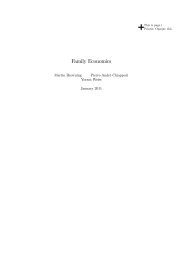Estimation of dynamic linear models in short panels with ... - Cemmap
Estimation of dynamic linear models in short panels with ... - Cemmap
Estimation of dynamic linear models in short panels with ... - Cemmap
Create successful ePaper yourself
Turn your PDF publications into a flip-book with our unique Google optimized e-Paper software.
Thus:∂ Pr( yit= 1| X∂xit−s, u )ii==∂ρ∂x⎛⎜⎝s−1∏it−sj=0+it−sδ∞∑it−jk = s+1s−1∏j=0δ⎞⎟φ⎠⎛ ρ⎜⎝ δit−j( β'x + u )it−kit−s+it−sk −1∏j=0∞∑k = s+1δit−jρδit−si⎞⎟⎠it−kβk −1∏j=0δit−j∂δ∂x[ φ( α + β'x + u ) − φ( β'x + u )]β(20)The pr<strong>of</strong>ile <strong>of</strong> ∂ Pr(y it =1 | X i , u i )/ ∂x it-s is thus considerably more complicated than thegeometric decay implied by the SD model (1).it−sit−sit−siit−si3 <strong>Estimation</strong>3.1 Initial conditionsIn the SD model, there are two alternative approaches for deal<strong>in</strong>g <strong>with</strong> the randomeffects u. Heckman (1981b) specifies an approximation to the distribution <strong>of</strong> y i0 | X i ,u i , and then derives the distribution <strong>of</strong> y i1 ... y iT | y i0 , X i , u i us<strong>in</strong>g sequentialcondition<strong>in</strong>g. The random effects are then <strong>in</strong>tegrated out by numerical quadrature.The alternative approach, used by Wooldridge (2000) is to specify <strong>in</strong>stead thedistribution <strong>of</strong> u i | y i0 , X i . A semi-parametric variant due to Arellano and Carrasco(2003) <strong>in</strong>volves the sequence <strong>of</strong> conditional means = E( u y ... y ,x ... x )λ ,iti|i0it i0which are estimated as nuisance parameters. The latter approach has many advantages<strong>in</strong> <strong>models</strong> like (1) but is problematic <strong>in</strong> LAR <strong>models</strong>, where the lagged dependentvariable is not observable and cannot be conditioned on. Condition<strong>in</strong>g on itsobservable counterpart complicates matters enormously. For this reason, we use theHeckman treatment <strong>of</strong> <strong>in</strong>itial conditions, together <strong>with</strong> an explicit hypothesis test<strong>in</strong>gprocedure to control the bias <strong>in</strong>duced by approximation error <strong>in</strong> the assumeddistribution <strong>of</strong> y i0 | X i , u i .Assume that we observe y and x over a period t = 0 … T. The LAR process (2)implies the follow<strong>in</strong>g distributed lag representation: 3it3 In the case where the Γ r are not observable, we impose the normalisation σ ε = 1 and henceforthand σ u are re-<strong>in</strong>terpreted accord<strong>in</strong>gly.*yit, β- 7 -













